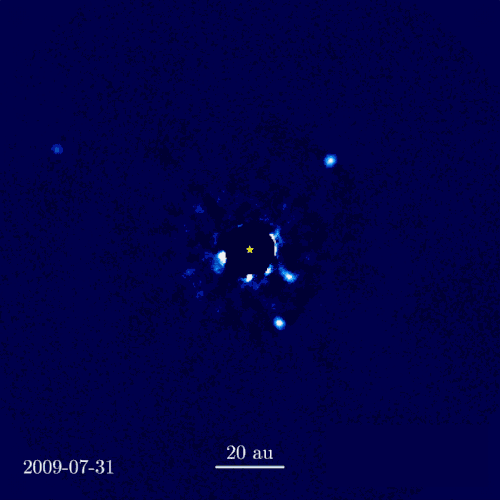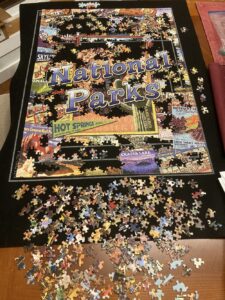March 29th, 2025 at 11:04 pm (Astronomy, Planets)
Exoplanets are generally discovered in indirect ways, by the slight wobble they impart to their host star, or by passing in front of the star and briefly dimming its light.
But here we have a glorious compilation of seven images taken from Earth over seven years, in which four exoplanets are directly imaged!

These planets are all orbiting a star named HR 8799, in the constellation Pegasus. The images were collected by the Keck Observatory in Hawaii. The source images were used to infer and interpolate the planets’ orbits. (This planetary system seems to be nearly perpendicular to us. Not all of them are, naturally.) Magical to watch.
Comments
March 12th, 2025 at 9:59 pm (Technology)
 So you have a flat tire and want to try out Fix-a-Flat, a spray can that claims to seal and re-inflate your tire for temporary use until it can be repaired. Your first and biggest challenge is… how to get the cap off.
So you have a flat tire and want to try out Fix-a-Flat, a spray can that claims to seal and re-inflate your tire for temporary use until it can be repaired. Your first and biggest challenge is… how to get the cap off.
You squeeze and fiddle and twist and squeeze some more, with no success. You then go to the Internet and discover that this is such a common problem that the Fix-a-Flat website (but NOT the can) comes with instructions on how to get the cap off. They recommend wedging the can under a non-flat tire for leverage so you can wiggle the cap off.
“Sometimes our Fix-a-Flat caps suffer from separation anxiety and don’t want to come off.”
It turns out, this works. It would have been nicer if they’d designed a cap that could be removed with human hands, which seems like a well solved problem. But I guess if you ever encounter another kind of problematic cap, you could try this technique there!
Comments
January 19th, 2025 at 1:17 pm (Games)
Jigsaw puzzles are an interesting type of object – once you’ve completed one, you don’t really want to keep it around. Would you ever want to re-do the same puzzle? But it’s probably in perfectly good condition. So, you can donate it to a charity, or if you are fortunate, you might be able to take it to a puzzle swap, like this one held at our local library on January 11, 2025. Bring as many as you want, take as many as you want!
I think this is a brilliant idea. I got to take 3 puzzles in and came home with two, one of which I’ve already eagerly started working on. “America’s National Parks” is a fantastic 1000-piece puzzle, complex enough to have interesting detail but no huge stretches of black/boring areas. I think it would be fun to do in a group since each person could have their own quest to fill in a particular park’s poster.

If you don’t know of a puzzle swap nearby, maybe you could suggest it to your library or a community center. Enjoy!
Comments
January 1st, 2025 at 7:02 pm (Engineering, Spacecraft, Technology)
Recently I enjoyed working through Coursera’s Rocket Science for Everyone taught by Prof. Marla Geha.
The course reminds us that achieving orbit is all about going horizontally fast enough that you “miss” the Earth’s surface. For our planet’s mass, to achieve low Earth orbit, that speed is about 7.6 km/sec. I was interested to learn that given our available chemical propulsion options, we almost didn’t make it to orbit.
The rocket equation defines the change in velocity (delta_v) that you get from a given fuel and rocket design:
delta_v = v_exhaust ln(rocket mass [initial] / rocket without fuel mass [final] )
Exhaust velocity (v_exhaust) is how fast material is pushed out of the rocket, given the fuel you are using. This value for our propellants is about 2-3 km/sec, which means you need something greater than 95% fuel in order to get to 7.6 km/sec and achieve low Earth orbit! (By making that natural log of the mass ratio large enough)
Fortunately, smart people figured out that you can work around this limit using multiple stages and discarding spent containers to improve your mass ratio as you go. But if our planet had been more massive, we would have had to get a lot more creative to find something that would work.
Another bonus: launching near the equator and west to east gives you 0.5 km/sec for “free” (if you want an equatorial orbit). But Vandenberg Air Force Base (not equatorial) is a good launch site if you want a polar orbit instead (no freebies).
I also learned that GPS satellites are not out at geostationary orbit (which would allow them always to be in view, and only require three total to cover the Earth) because they didn’t want to have to build ground stations for them all over the Earth (i.e., in other countries) but instead just in the U.S. Interesting.
Great class – I recommend it!
Comments
November 22nd, 2024 at 6:17 pm (French, Language)
I just discovered this delightful example of a holorime, which is a sequence of sounds that can be formed by different choices of underlying words, leading to completely different meanings. This one crosses languages. Although it is written in French, if you pronounce it out loud, you’ll soon discover that it sounds like you’re reading “Humpty Dumpty” in English but with a strong French accent:
Un petit d’un petit
S’étonne aux Halles
Un petit d’un petit
Ah! degrés te fallent
Indolent qui ne sort cesse
Indolent qui ne se mène
Qu’importe un petit d’un petit
Tout Gai de Reguennes.
From “Mots d’Heures: Gousses, Rames”, shared by Elly on Bluesky.
Wow! It tickles my brain. Wikipedia notes that holorimes are related to mondegreens, which are alternative hearings of song lyrics. The first one that comes to my mind is hearing about a fan asking John Prine to play the “Happy Enchilada” song, which left him at a loss, until the fan continued, “You know – it’s a happy enchilada and you think you’re gonna drown!” Then he figured out that she was asking for his song titled “That’s the Way the World Goes Round”, which includes the line “It’s a half an inch of water and you think you’re gonna drown.”
It’s a marvel that our brains can translate sound waves into words at all, and these are fun examples that play with the edges of that ability. Picking out words from one language to assemble the sounds of real words in another language is genius!
Comments

 So you have a flat tire and want to try out Fix-a-Flat, a spray can that claims to seal and re-inflate your tire for temporary use until it can be repaired. Your first and biggest challenge is… how to get the cap off.
So you have a flat tire and want to try out Fix-a-Flat, a spray can that claims to seal and re-inflate your tire for temporary use until it can be repaired. Your first and biggest challenge is… how to get the cap off.